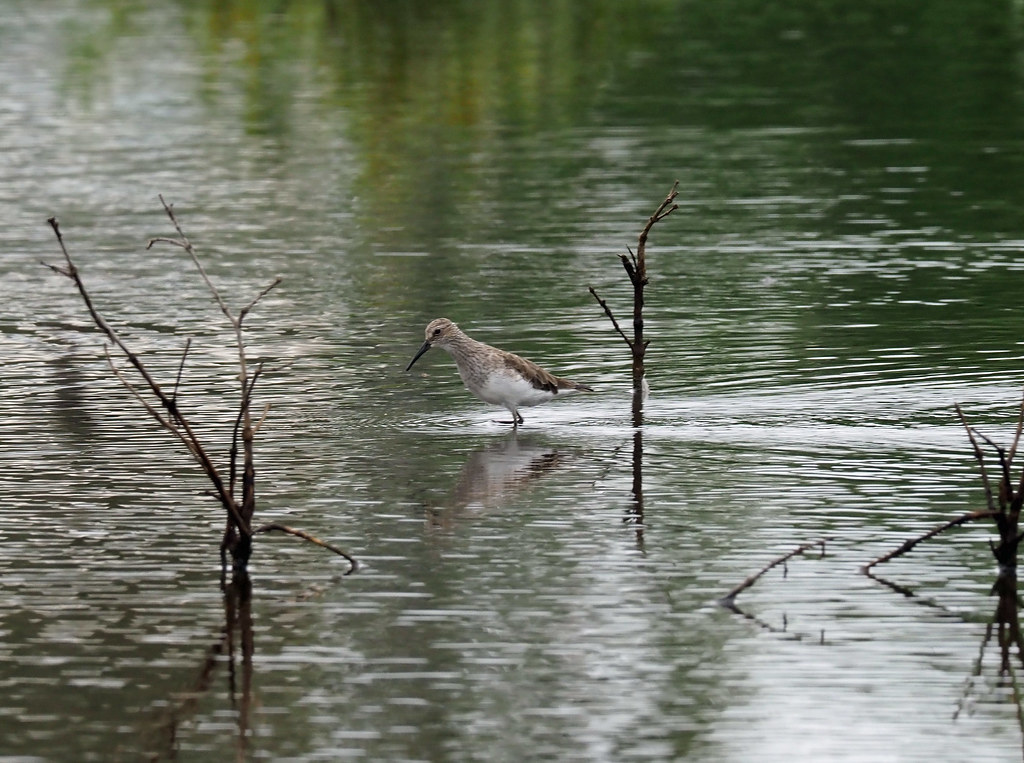|
|
|
|
|
|
|
|
|
|
|
[HBW - BirdLife (v3)] |
29/04/2024 10:57:27 AM |
|
|
| |
| Species Details [Taxonomy: HBW - BirdLife (v3)] |
|
|
| NR |
|
Cox's Sandpiper* |
Id (Atlas): |
822 |
| |
|
Calidris paramelanotos |
Vagrant |
Description (8)

|
Cox's Sandpiper
© flickr.com
|
|
|
Medium small. Long, black, slightly decurved bill. A hybrid between a female Curlew Sandpiper (Calidris ferruginea) and a male Pectoral Sandpiper (Calidris melanotos). Sexes alike.
Adults: Breeding: Crown, brown with dark streaks. Neck, back, scapulars, teritials, blackish-brown strongly edged with pale rufous, darker on tertials. Lower back, rump, blackish. Eyebrow, white indistinct. Eyering, white. Eye, dark brown. Lores, dark. Tail, blackish-brown, feathers edged with buff, progressively becoming paler toward out feathers. Wings, dark brown, greater and primary coverts tipped white forming a narrow wing bar. Breast, streaked. Face, throat, lower breast, belly, undertail coverts, whitish. Lower neck, breast, pale rufous. Entire underparts white and devoid of spots. Underwing, white. Bill, black, some having a yellowish base. Legs, yellow-green. Non-breeding: Upperparts, dark brown and lacking rufous edges to feathers. Crown, face, neck, breast, streaking less distinctive. Breast, pale browish-grey, but not strongly cut-off at lower breast. Underparts white and devoid of spots.
Immatures: Similar to non-breeding adult, but with scaly pattern from fine pale feather margins on upperparts.
|
Family
Scolopacidae (Sandpipers, Snipes, Phalaropes)
Size
19 cm
First Described (Guide)
Parker, 1982
Derivation
Cal-id'-ris - Gk, (or scalidris), a kind of bird: paramelanotos - Gk., para, ?: mel-an-o'-tos - Gk, melas, melanos, black: Gk, notos, back
Abundance (Guide)
R - V
Rare summer migrant.
Habitat
Fresh and marine wetlands, tidal mudflats, salt farms, sewerage ponds.
|
|
|
Breeds in northern hemisphere, migrating south to Australia and New Zealand.
|
| |
Rarity Status
Currently this species is not classified as a rarity in this country OR information has not been updated.
Status NR
For more information see BirdLife International Species Factsheet.
Food
Seeds, worms, molluscs, crustaceans and insects.
Voice
A loud, harsh, 'trilt'.
Breeding Season (Guide)
Does not breed in Australia.
Subspecies
Considered a hydrid of male Pectoral Sandpiper (Calidris melanotos) and female Curlew Sandpiper (Calidris ferruginea).
No subspecies.
Similar Species
Sharp-tailed Sandpiper (Calidris acuminata)
Similar size. Non-breeding with non-breeding. Crown, some chestnut. Underparts, mostly white, but with streaks on flanks. Bill, shorter, dark brown, but only slightly decurved, and yellowish at the base.
Pectoral Sandpiper (Calidris melanotos)
Similar size. Non-breeding with non-breeding. Crown, dark but not chestnut. Breast, pale browish grey, strongly cut-off at lower breast. Underparts, mostly white, no streaks on flanks. Bill, shorter, also slightly decurved, but heavier and olive-yellow at the base.
Curlew Sandpiper (Calidris ferruginea)
Similar size. Non-breeding with non-breeding. Crown, dark but not chestnut. Eyebrow, long and white. Lores, blackish. Upperparts, greyish brown. Underparts, white with pale grey brown lightly streaked sides to breast. Bill, longer, black, and strongly decurved.
Compare Images
References
See References.
The Field Guide to the Birds of Australia Pizzey, G., and Knight, E., 1997, Angus & Robertson, Sydney ISBN 0 207 19691 5
Field Guide to Australian Birds Morecombe, M., 2000, Steve Parish Publishing Pty Ltd. ISBN 1 876282 10 X
Field Guide to the Birds of Australia Simpson, K., and Day, N., 1999, 6th Edition, Viking ISBN 0 670 87918 5
Reader's Digest Complete Book of Australian Birds 1988, 2nd Edition, Reader's Digest ISBN 0 949819 99 9
What Bird is That? 1984, Revised Edition, Angus & Robertson, Sydney ISBN 0 207 14846 5
Handbook of Australian, New Zealand & Antarctic Birds 1990 - , Oxford University Press, Melbourne ISBN 0 19 553244 9
Files:

BirdLife International
For more information about the Coxs Sandpiper see...  BirdLife International Species Factsheet. BirdLife International Species Factsheet.
Articles about the Coxs Sandpiper
If you would like to read any articles about the Coxs Sandpiper...  Show Articles (0) Show Articles (0)
No Pictures of Coxs Sandpiper
If Birdpedia has no pictures of Coxs Sandpiper or you would like to see more, then try the following...
 From BING (0) From BING (0)
No Videos of Coxs Sandpiper
If Birdpedia has no videos of Coxs Sandpiper or you would like to see more, then try the following..
 From BING (0) From BING (0)
Where can I observe this species?
On What Field Trips was this species observed?
Latest Sightings for Coxs Sandpiper
|
|
|
|
|